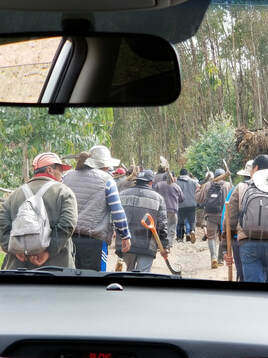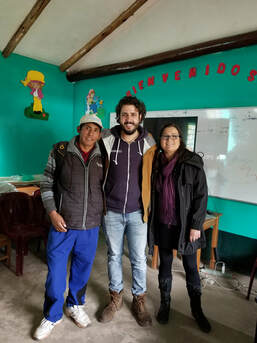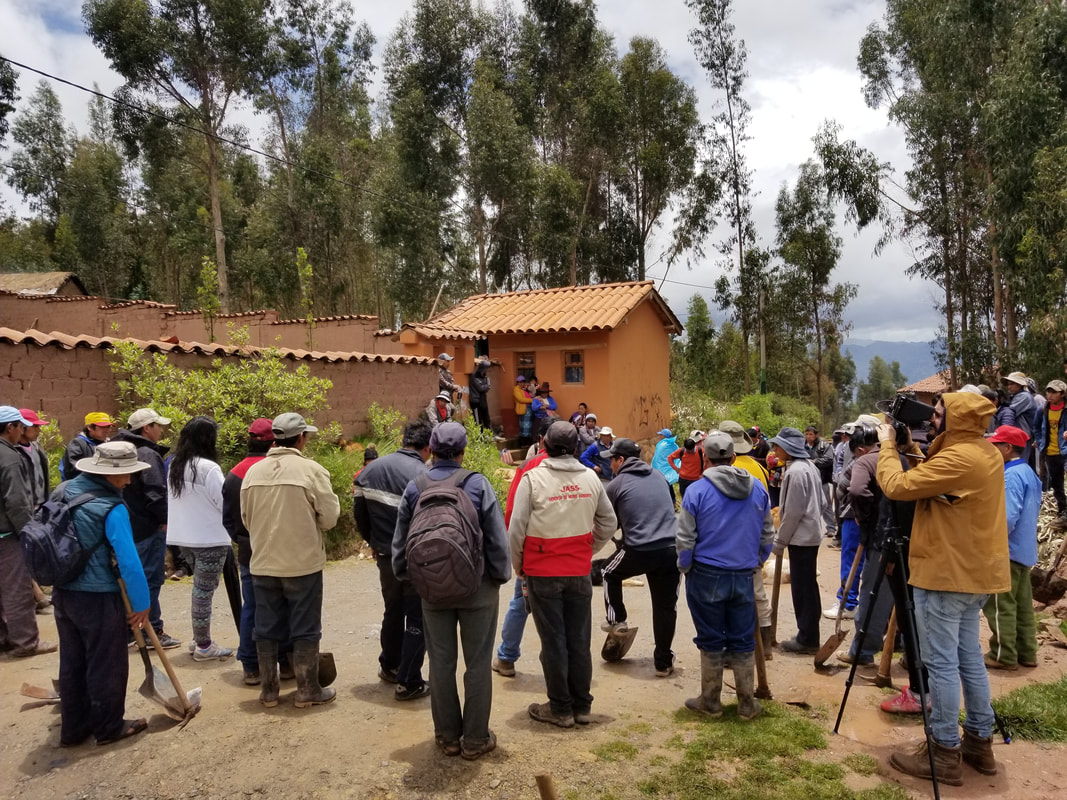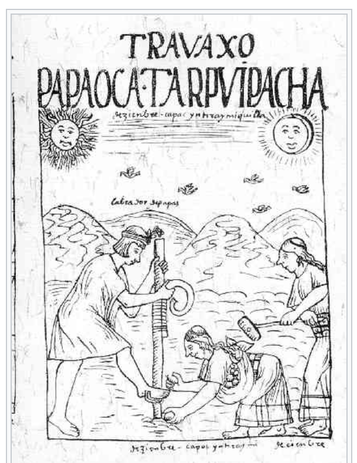 View of the whole community walking up the hill for the meeting with tools in hand. View of the whole community walking up the hill for the meeting with tools in hand. Sunday, February 3rd 7AM I'm up early once again to get ready for a big community meeting in the community of Fortaleza...the community that is the closest to the main Saqsaywaman complex. We've been working closely with the past President of this community, Fernando Sallo, since we arrived to tell his story. Today, we meet with the whole community to show them our film Stone & People, and hopefully gain their trust so we can continue to work with this group. Dalton Gaudin and I worked hard to re-edit the film to put in Spanish subtitles and make it a little shorter. Today will be the test to see if our work in the past justifies to this cohesive community our continued presence amongst them. Given the less-than-enthusiastic reception we've had in the other two communities, I'm up early this morning not because my alarm went off. I'm nervous. As we drove up, we found ourselves behind what seemed like the WHOLE community with picks, shovels and machetes marching as a work crew up the hill for their meeting and then our screening. I'm struck with how every able bodied man and woman has turned out on this rainy Sunday morning.
 After the screening, Adrian Sallo poses with Dalton and Maren before we all head off to the work party. After the screening, Adrian Sallo poses with Dalton and Maren before we all head off to the work party. 9:30 - 10AM Screening After a brief introduction to the film by Dalton Gaudin, we decided to show the entire film. We were tempted to skip some of the history in the beginning of the film, but it turned out that the whole group of 75 people were totally focused during the entire movie. There were even period of laughter as they recognized Adrian Sallo in one scene and Fernando in another. As a whole, this community seemed to really appreciate what we had done in 2010 to 2012 and understood the value of film to communicating their situation as living culture on an active archaeological site. A brief question and answer period followed the screening with some really good questions being raised. We were thanked for our work and we were welcomed to continue our work starting with covering today's work party. They are also really interested in us coming back for the March 1st community festival; an event they feel will give us a good sense of what all the communities do as a whole to honor traditions and rituals.  Dalton films the second community meeting outside Fernando's house where they all weigh in on how best to run the power line. This meeting is a good example of the concept of Ayni. Dalton films the second community meeting outside Fernando's house where they all weigh in on how best to run the power line. This meeting is a good example of the concept of Ayni. 10:30AM - 3:50PM Community Negotiations About Running New Power Line Running power to these communities is always a challenge, but today's job poses a unique problem. The power line needs to be run right through the front yard and already constructed bathroom house of Fernando Sallo. As is the custom when there's a disagreement in a community, ALL the members get together and discuss. So, they all meet outside the fence of Fernando's house and everyone weighs in about how to go about running the line with the least disruption to Fernando's property. Bottom line, some type of destruction must be done on Fernando's property, but I'm impressed with how they all try their best to find a solution that will be good for all. This attitude about working as a community was explained to us by Fernando as coming down from ancient Inca times and described as a system of Ayni, Minka & Mita. Ayni: It was a system of work of family reciprocity between the members of the ayllu, destined to agricultural works and to the constructions of houses. The ayni consisted in the help of work that a group of people did to members of a family, with the condition that it corresponded in the same way when they needed it, as they say: "today for you, tomorrow for me" and in return They served food and drink during the days the work was done. This tradition continues in many peasant communities of Peru, helping in the work of cooking, herding and housing construction.
Mink'a: The minca, minka, or minga, is the community work that was carried out in works in favor of the ayllu and the Sun (Inti), a tax in work and in turn, that had as beneficiary to the State, where many families attended carrying their own tools and food. The families participated in the construction of premises, irrigation canals, forts, mines, cultivation of state lands, as well as assistance in the fields of the disabled, orphans and the elderly. Overall, the community good takes precedent over an individual's sole benefit.
 Travaxo "A System of Work" was outlined in (1615/1616), by Felipe Guamán Poma de Ayala, in his chronical of Incan life. Travaxo "A System of Work" was outlined in (1615/1616), by Felipe Guamán Poma de Ayala, in his chronical of Incan life. Can The Andean Philosophy of Ayni, Mink'a & Mita Play A Role In The Conflict With The Ministry of Culture? Over the last few weeks of interviews with the various communities, it has occurred to both Dalton and myself that the process of community involvement in ANY decision is NOT being practiced by the Ministry in dealing with the communities. It seems, and we will confirm this this week when we talk with the park director, that the relationship the Ministry has with the communities DOES NOT follow the ancient practice of Ayni, Mink'a & Mita. Why isn't this amazing group philosophy used by the Ministry? We will seek to find out. In the meantime, understanding the last of the concepts is appropriate. Mita may hold the key. Mita: The mita was a system of work in favor of the Imperial State of Tahuantinsuyu, where crowds of people were mobilized to work in turn in the construction of roads, bridges, fortresses, administrative centers, temples, aqueducts, mining, etc. There was a mita for special services such as the work of Sapa Inca freighters, musicians, chasquis and dancers, those forced to perform this task were married men adults, but not women, whose age was between 18 and 50 years. So, the question is: Is there a role for this type of intimate collaboration for the benefit of the State/Ministry of Culture in the name of preservation of this amazing archaeological site known as Saqsaywaman? A site that is also known as HOME to these people who represent living culture that is just as important as the stones left by their ancestors? It is these questions we walk away from today with and hope to get answered later this week in our meetings with the Ministry of Culture professionals. Because, they too are Quecha community members and, as such, would benefit from the ability to have the in-depth negotiations about site preservation just like this community had hard conversations today about removing Fernando's wall.
We were rewarded today with some cute moments with animals and beautiful plants. At the end of a rewarding but long day, seeing a beautiful hummingbird, a cute doggie and a beautiful plant I've never seen before were rewards that were much appreciated.
2 Comments
|
Author
Maren Elwood is a visual anthropologist and founder of On-Site Expeditions...a field school that will provide scholarships to aspiring heritage professionals. The first field school session will be in January 2020. Archives
September 2023
|